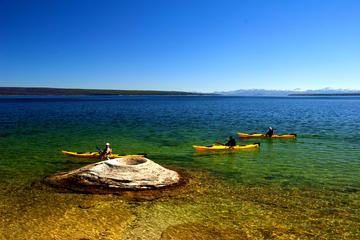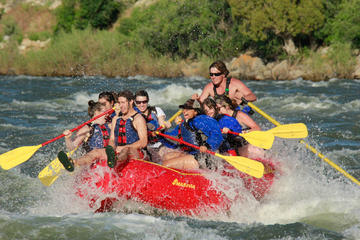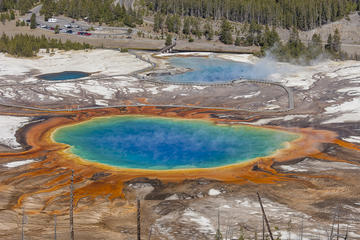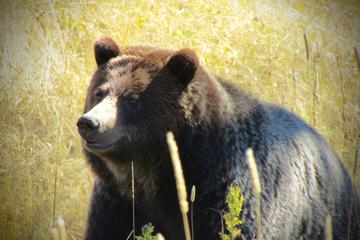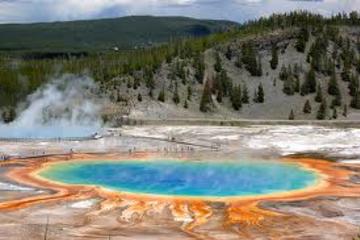Yellowstone National Park
Explore America’s First National Park.
A hot bed of geothermal features and incredible views
Yellowstone National Park was the first national park established in the United States, and is widely held to be the first national park in the world. It has a number of interesting features and activities, and with something for everyone, it is one of the most visited national parks.
Over 4 million people visit Yellowstone each year, most between May and September, although the park is open year-round and there are visitors at all times. The busiest months to visit are July and August.
There are several things people come to Yellowstone to see and do. Its wildlife and geothermal features make exploring all the areas of the park an adventure, and it also hosts spectacular views of geographic features, such as the Grand Canyon of the Yellowstone. In addition to fantastic sights accessible by car and day hiking, backcountry hiking, bicycling, and boating are all available to break away from the crowds and experience something new. We were also very excited for the opportunity to fish in a few places in the park!
In the winter, some of the additional activities that are available are cross country skiing and snowshoeing. There are road closures to motor vehicles in the winter time, and all unplowed roads and trails are open to skiing and snowshoeing, in addition to track being set on a number of trails. This allows you to journey in developed areas or through the backcountry (whichever you do, make sure to be prepared, and read on below!). Another fun way to experience Yellowstone in the winter is via snowmobile or snowcoach tours or shuttles. There is also a lottery for non-guided snowmobile experiences.
Open / Close / Reopening Status of Yellowstone National Park due to Coronavirus (COVID-19)
More information on Yellowstone
Last Updated: May 2, 2020
History
The human history of Yellowstone can be traced back about 11,000 years, based on dating of an artifact found while constructing a post office in Gardiner, MT, at the North end of the park. The original visitors seem to have used the land for hunting and fishing, and the Hidasta (a Siouan people) word for the area is “Mi tsi a-da-zi” (Rock Yellow River). Early French trappers called the area “Roche Jaune”, which American trappers rendered as “Yellow Stone.” It is widely believed that the river was named for the yellow rocks seen in the Grand Canyon of the Yellowstone, which transects the park.
Explorers in the Lewis and Clark Expedition (1805) encountered native tribes in the region and heard about the Yellowstone region while they were in (present-day) Montana, but no one from that expedition visited the area of the park. In 1806, John Colter left the expedition to join some fur trappers, and left them in 1807. He passed through part of the park, and observed geothermal features in a section of the park near Tower Fall. His tales of “fire and brimstone”, although followed up by stories of others throughout the next 40 years, were believed to be mythical, an imaginary, delirious “Colter’s Hell.” Other mountain men and trappers, such as Jim Bridger described boiling mud, petrified trees, spouting water, and rivers of steam, but it was unlike anything that had been seen before, and was dismissed.
Storms in the late 1850s and the Civil War in the 1860s hampered organized travel into the region until 1869, when the Cook-Folsom-Peterson Expedition entered the area. The three explorers were privately funded, and followed the Yellowstone River to Yellowstone Lake. The following year, a group of Montanans lead by Henry Washburn and including Nathaniel (later “National Park”) Langford, spend a month exploring the area. Finally, in 1871, geologist Ferdinant V Heyden, whose expedition 11 years before with guide Jim Bridger had been interrupted by storms, obtained sponsorship by the federal government to return with a larger expedition, the Hayden Geological Survey. His report, which included paintings (Thomas Moran) and photographs (William Henry Jackson), convinced Congress to remove the land from public auction. On March 1, 1872, The Act of Dedication law was signed by President Ulysses S Grant, thereby creating Yellowstone National Park. Hayden had not been the first person to have thought of conserving the region or creating a park there, but he was its most enthusiastic supporter.
Local entrepreneurs in the early years of the park sought to have federal land-use restrictions lifted, in order to increase use of area resources (mining, hunting, logging). The numerous bills introduced in Congress by Montanan legislators and others served to impede the park’s first superintendent, Nathaniel “National Park” Langford, who was appointed to the post by the Secretary of the Interior. Langford served without salary, funding or staff for five years, and battled having no means to protect or improve the park and its land. Yellowstone suffered attacks by poachers, vandals, and others who stripped its resources away. Langford was forced to step down due to a report of poaching in 1877; however the following four park superintendents also suffered from a lack of funding and support, and were unable to fully protect the park. In 1886, the US Army arrived at Mammoth Hot Springs and established Camp Sheridan (which remains today as a visitor center and other buildings) which was later renamed Fort Yellowstone. Congressional action finally established the Park Protection Act and the Lacey Act of 1900 (which allowed officials to prosecute poachers), allowing the army to develop their own policies for protecting the park, wildlife, and natural resources. In 1916, the National Park Service was created, adopting many of the managment ideas developed by the army. On October 31, 1918, the army turned control of Yellowstone over to the National Park Service.
The Northern Pacific Railroad extended a line to Montana, at the northern entrance of the park, in the early 1880s, which enabled park visitors to grow drastically to over 5,000 in 1883. The rough roads of the early years were largely accessible only by horse or by stagecoach. Visitation continued to increase, attracting a Union Pacific Railroad line to West Yellowstone, though by World War II, the number of visitors arriving by rail began to decrease, and the lines were closed down within twenty years. Many of the railroad lines were converted to nature trails, including the Yellowstone Branch Line Trail. By 1915, automobile traffic in the park had reached about 1,000 vehicles a year, causing conflicts with horses and stagecoaches. Eventually, horse travel on park roads was prohibited.
The Civilian Conservation Corps (CCC), a relief agency formed as part of President Roosevelt’s New Deal, helped develop Yellowstone facilities between 1933 and 1942. CCC projects in Yellowstone included reforestation, the development of many of the park’s trails, early visitor centers and campgrounds, as well as fire-fighting and fire hazard reduction. The CCC played a major role in a number of different parks, and it would be difficult to imagine what our National Parks would look like without the hard work of those young men.
Renewed post-war visitation led to modernization efforts in the 1960s, with Mission 66 celebrating the 50th anniversary of the park service and bringing change to the park. Traditionally, structures had been designed in the log cabin style, but Mission 66 construction featured a more modern style. Construction in the 1980s featured more traditional designs, including structures rebuilt after a forest fire at Grant Village in 1988. The Canyon Village visitor center, which was finished in 2006, features more traditional design features as well.
Geography and Geology
Most of Yellowstone is within the state of Wyoming, with a small part in Montana and Idaho. North to south, the park is 63 miles long, and it is 54 miles wide. With an area of over 2 million acres, the park is larger than states like Rhode Island or Delaware. Over 5% of the park is covered in water, the largest of which is Yellowstone Lake, which has 110 miles of shoreline and is up to 400 feet deep. It is also the largest high altitude lake in North America, laying at 7,733 feet above sea level.
The Continental Divide of North America runs diagonally through the southwestern part of the park, and is a topographic feature that separates water drainages between the Pacific Ocean and Atlantic Ocean. About one third of the park lies on the west side of the divide. The Yellowstone and Snake Rivers originate near each other, but on opposite sides of the divide. Because of this, the Snake River flows to the Pacific Ocean, and the Yellowstone River flows to the Atlantic Ocean through the Gulf of Mexico.
The entire Yellowstone Plateau sits at about 8,000 feet above sea level, and is bounded by mountain ranges of the Middle Rocky Mountains, which vary in elevation from 9,000 to 11,000 feet. The highest point in the park is the top of Eagle Peak (11,358 feet) and the lowest is along Reese Creek (5,282 feet). There are three canyons in the park, and the Yellowstone River has carved two of them, the Grand Canyon of the Yellowstone and the Black Canyon of the Yellowstone. In the south end of the park, the Lewis River winds through Lewis Canyon.
Yellowstone is a massive caldera of a supervolcano, which erupted long ago and buried trees in ash and soil, creating one of the world’s largest petrified forests. The supervolcano is the largest volcanic system in North America, and the caldera was created in a series of large explosions, the last of which was about 640,000 years ago. The largest known eruption was 2.1 million years ago, with a smaller eruption 1.3 million years ago. Each eruption deposited ash across hundreds of miles of North America, and the gases released into the atmosphere likely changed world weather patterns; both would have led to the extinction of some species, especially in North America.
The magma chamber underneath Yellowstone leads to a number of geothermal features. The park contains half of the world’s geothermal features and two-thirds of the world’s geysers. The five types of geothermal feautres are fumaroles (steam vents), mudpots, geysers, travertine terraces, and hot springs. Arguably the most famous geothermal feature is Old Faithful, a geyser in the middle of the park. Unlike most of Yellowstone’s geysers, which are small and don’t erupt more than two feet, Old Faithful sends boiling water over 100 feet in the air, and erupts every 45 to 125 minutes. It was the first geyser named, by the Washburn-Langford-Doane Expedition of 1870, who noticed its reliability in erupting.
Fumaroles – also known as steam vents, one of the hottest hydrothermal features in the park, where the water flashes to steam before reaching the surface.
Geysers – periodically erupt scalding hot water, due to pressure changes and water boiling under the earth’s surface.
Hot springs – the most common hydrothermal features in Yellowstone. As superheated water reaches the surface, it cools and sinks, being replaced by hotter water from below. This circulation (convection) prevents the surface from reaching the termparature needed for an eruption, so streams of heated water are released. Some hot springs in the park are home to heat-loving bacterium, which gives some of the hot springs some color.
Mudpots – a fun feature of Yellowstone, mudpots are acidic hot springs with a more limited water supply. The acidity of the mudpots comes from microorganisms who use hydrogen sulfide, which rises from deep within the earth and gives the rotten egg smell experienced at different parts of the park, as an energy source. These organisms give off sulfuric acid as a byproduct, and the acid breaks down rocks into clay. When the limited water boils up through the clay, it creates bubbles in the mud, splashing mud all around.
Travertine terraces – these features are found near Mammoth Hot Springs, and occur when thermal water rises through limestone (calcium carbonate). Dissolved carbonate is carried with the water and is deposited on the surface as travertine, a chalky white rock.The terraces grow and change as more travertine is deposited.
Entrance Fee
A number of options are available to access the park. During the warm months, private non-commercial vehicles can access Yellowstone for $30, or both Yellowstone and Grand Teton National Park for $50. Motorcycles and snowmobiles (by permit) can access Yellowstone for $25 or both parks for $40. These passes are good for 7 days. The Yellowstone National Park Annual Pass is $60 and is good for 1 year from month of purchase. All of the Interagency passes, such as the Annual Pass ($80) and Senior Pass ($10), are accepted.
Location
Nearby Cities
West Yellowstone, Montana: Lies just outside the west entrance. This town was originally founded when the Union Pacific railroad line, the Oregon Short Line, was finished in 1908. It went through a few name changes before West Yellowstone was selected as the name in 1920. It is the home of the Yellowstone Airport (WYS), which operates from about June to September. Delta operates 1-2 flights per day from this airport to Salt Lake City, where connections can be made across the United States and abroad. The town of West Yellowstone supports tourists visiting Yellowstone, including a number of tourists visiting from China, by offering lodging and other amenities. Bus tours, self guided tours, and guided tours are available from West Yellowstone into Yellowstone (as well as Grand Teton National Park, to the south).
Gardiner, Montana: Lies just outside the north entrance. The name originates with a trapper, Johnson Gardner, who operated in the area in 1830-31 and had named the valley around the headwaters “Gardner’s Hole,” and the river “Gardner’s Fork.” Future prospectors and explorers kept the name although were not aware of the trapper, and by the time the Washford-Langford-Doane Expedition of 1870 visited, they were spelling the name with a phonetic error: “Gardiner.” So too, did two budding entrepreneurs discovered by the Hayden Geological Survey of 1871 who had laid claim to a 320 acre parcel at Mammoth terraces, and who established a ranch and bath house and later a primitive hotel. One of them, J.C. McCartney, went by “Jim Gardiner” and received mail for himself and hotel guests as “Jim on the Gardiner.” McCartney and his partner, H.R. Horr, were not evicted from the park until many years after the park was established in 1872. In 1880, a territorial post office named Gardiner was established outside the park’s northern boundary, and the town soon followed. It served as an early entrance to the park, and in 1883, a branch line was built from the Northern Pacific line through Livingston, Montana, to Cinnabar, a few miles north of Gardiner. When the line was extended to Gardiner in 1903, Cinnabar became a ghost town and is no longer on the map. As automobile traffic increased, the rail service to Gardiner ceased in 1948. Today, the town supports tourists visiting the park, providing gear (Parks’ Fly Shop has been open since 1953), lodging, and other amenities. Gardiner is also the location of the Yellowstone National Park Heritage and Resource Center, which houses NPS archives, Yellowstone museum collections, and reference libraries about the area. The town is located on the 45th parallel (the sign is just below the town on the way into the park) and is halfway between the North Pole and the Equator.Bus tours, self guided tours, and guided tours are available from Gardiner into Yellowstone.
Cody, Wyoming: Near the east entrance of the park. This town was named for William Frederick “Buffalo Bill” Cody, who played a part in the creation of the town. The town is served by the Yellowstone Regional Airport (YRA), where SkyWest/Delta offers flights to Salt Lake City and SkyWest/United flies to Denver (from both of these airports, connections can be made across the United States and abroad). Visitors to the town can enjoy its Western, pioneer, and Cowboy themed activities, including five museums located together at the Buffalo Bill Historical Center, Old Town Trail, and daily amatuer rodeo throughout the summer (June 1-August 31) with a professional rodeo over the July 4th holiday. Western style furniture and a number of artists also add to the cultural identity of Cody. Bus tours, self guided tours, and guided tours are available from Cody into Yellowstone (as well as Grand Teton National Park, to the south).
Bozeman, Montana: located in central Montana about an hour and a half from Gardiner and the North entrance of the park. A college town, Bozeman is home to a number of tech businesses and the Museum of the Rockies, as well as being named the best place in the West to live for skiing (Outside, August 2010). It is also home to the Bozeman Yellowstone International Airport (BZN), which offers flights to cities across the country.There are a number of airlines operating from Bozeman on a regular and/or seasonal schedule, each offering a few destinations. Alaska Airlines (Seattle/Tacoma WA daily, Portland OR seasonally); Allegiant Air (Las Vegas NV biweekly, Phoenix/Mesa AZ biweekly); American Airlines (Dallas/Fort Worth seasonally); Delta Air Lines and Delta Connection (Daily: Minneapolis/St Paul MN, Salt Lake City UT, Seattle/Tacoma WA, Seasonally:New York LaGuardia, Atlanta GA and Los Angeles CA); Frontier Airlines (Denver CO seasonally); Jet Suite, a private company (San Jose CA, seasonally); United Airlines (Denver CO daily; seasonal service to Chicago O’Hare, Los Angeles, San Francisco, New York-Newark, and Houston TX). From these airports, connections are available across the United States and abroad.
Park Lodges and Camping
Park Lodges and Inns at Yellowstone are operated by Xanterra, an authorized concessioner. There are nine lodges open in the summer time, offering 2,000 rooms, and in the winter time, two lodges are available (although Mammoth Lodge will be undergoing renovations during winters until 2018 and lodging will not be available there as per normal). Xanterra also operates a few of the campgrounds within the park (there are others which are overseen by the National Park Service).
Summer Lodging
- Canyon Lodge & Cabins–located on the east side of the park near the Grand Canyon of the Yellowstone, this facility is open June through October and offers over 500 rooms. A renovated main building, with restaurant and gift shop, reopens in 2017.
- Grant Village–located near West Thumb of Yellowstone Lake, this facility features 300 rooms and is named after the president who signed into law the Act that created Yellowstone National Park in 1872, Ulysses S Grant. This lodge is open May through October, and also offers a full restaurant, a casual lakeside restaurant, a lounge and a gift store. It is also the closest lodge to Grand Tetons National Park, which lies just south of Yellowstone.
- Lake Lodge Cabins–located on Yellowstone Lake, these 186 cabins are open June through September and offer three different kinds of cabins centered by a main log-cabin lodge, where guest amenities such as a gift shop, lounge, and fireplace are available.
- Lake Yellowstone Hotel & Cabins–located on Yellowstone Lake, this hotel first opened in 1891 and is found on the National Register of Historic Places. A recent renovation restored the Colonial Revival architecture to its full glory. This facility is open from May to October and features 194 guestrooms between the hotel (Premium Hotel Room, Superior Room, Suite and Presidential Suite) and the Sandpiper Lodge (Standard Room), and 110 Frontier cabins. There is a full-service restaurant, casual deli, lounge, business center, gift shop, and scenic boat tours of Yellowstone Lake.
- Mammoth Hot Springs Hotel & Cabins (Hotel is CLOSED through Spring of 2018)–located, and named after, the Mammoth Hot Springs, this 211 room facility is typically open for the winter from December to March and in the summer from May to October. For Winter 2016-2017, both the hotel, most hotel common areas, and cabins are closed for renovations; in Summer 2017, only the cabins will be available; for Winter 2017-2018, both the hotel, most hotel common areas, and cabins are closed for renovations, with all facilities expected to be open for Summer 2018, with significant improvements to be observed. Throughout the renovation, the casual dining restaurant Terrace Grill will be available, and will feature a small gift shop and ski rentals. The hotel rooms include both suites (with the only in-room TVs at Yellowstone) and standard rooms (which will all include a private bath when the renovations are complete), and the cabins vary in size and accommations, including those with a hot tub. Mammoth Hot Springs facilities feature a full-service restaurant and casual dining (Terrace Grill), a gift shop, a ski shop, a lounge, and a unique Map Room, featuring a large map made up of wood from around the world.
- Old Faithful Inn–located at Old Faithful geyser, this National Historic Landmark hotel was built in 1904 with local logs and stone, and is considered the largest log structure in the world. It is one of the most requested lodging sites at the park, and features amazing views of the park’s most regular geyser. With 327 rooms, the Inn is open from May to October, and features a full-service restaurant, casual dining, and a coffee shop, as well as a lounge and a stunning lobby area with soaring, 65 feet ceilings and a number of intricate and rustic features such as a handcrafted clock.
- Old Faithful Lodge Cabins–located at Old Faithful geyser, this one-story main-lodge building was built in the 1920s, and has two kinds of cabins available from May to October. The main lobby, which has great views of the Old Faithful geyser, features a bakery/snack shop and a cafeteria.
- Old Faithful Snow Lodge–located at Old Faithful geyser, this lodge is open for the summer between April and October and then reopens in the winter from December to February. This facility has 134 rooms and cabins, and was completed in 1999, making it the newest park lodging. There is a full-service restaurant, casual dining, and a gift shop.
- Roosevelt Lodge Cabins–located near Tower Falls, this lodge was built in 1920 near a campground once used by President Theodore Roosevelt. Open from June through September, these 80 rustic units are located near a large corral operation with horseback trail rides and stagecoach adventures. The corral also offers the Old West Dinner Cookout, with steaks, real-life wranglers, and some of the best scenery Wyoming has to offer. There is also a restaurant and a gift shop in the main lodge.
Winter Lodging
Old Faithful Snow Lodge and Mammoth Hot Springs Hotel & Cabin are typically open for winter guests from December to February or March. As discussed above, Mammoth Hot Springs is closed to overnight guests for Winter 2016-2017 and Winter 2017-2018, although it will have some amenities, like the casual dining location Terrace Grill, open. The Old Faithful Snow Lodge does require over-snow transportation, as the roads are closed to vehicular traffic throughout the winter.
Summer Camping
- Madison Campground
- Grant Village Campground
- Canyon Campground
- Bridge Bay Campground
- Fishing Bridge RV Park (hard sided RVs only).
Distance from Nearby Cities (from West Thumb):
West Yellowstone, Montana: Approximately 50 miles, about 1 hour, 15 minutes drive
Gardiner, Montana: Approximately 75 miles, about 2 hours drive
Cody, Wyoming: Approximately 100 miles, about 2 hours drive
Jackson, Wyoming: Approximately 75 miles, about 2 hours drive
Salt Lake City, Utah: Approximately 350 miles, about 6 hours drive
Roundtrip Flights to Salt Lake City
[tp_in_our_city_fly_shortcodes destination=SLC title=”” limit=15 paginate=false stops=1 one_way=false off_title=true subid=”” currency=”USD”]
Don’t Miss:
Other Activities
Hiking Trails:
Yellowstone has over 900 miles of trails, many of them in the backcountry. Overnight trips require a permit, but day hikes do not.
Day hikes are available from each major area in the park. There are a variety of trails in both length and difficulty; be sure to check out the map of the trail you select to make sure that it is sufficiently easy for each member of your party, and check in at a ranger station the day of to ensure conditions are as expected and the area is not closed due to bear activity (especially in the spring). Remember to take appropriate precautions for the park’s wildlife and conditions. Bear spray is a good idea to carry on any hike (we recommend renting one, as they cannot be taken on an airplane when you leave), and stay on all trails and boardwalks at all times – there are undiscovered and unmarked geothermal features throughout the park.The surface is also thin over some geothermal features that have not fully developed yet. Check out the NPS day hike trail guide here (https://www.nps.gov/yell/planyourvisit/dhsampler.htm) and enjoy! We look forward to hearing about what you discover!
Extended backcountry hikes are also available beginning in all the different areas of the park. A fraction of the 300 backcountry campsites are available for advanced reservation (via mail, fax, or in person) which can be converted to a permit. After obtaining your permit from the backcountry office (permits are only available in person, within 48 hours of your trip), you can set out with your bear spray, bear canister, water filter, and a camera to discover an amazing wilderness. (https://www.nps.gov/yell/planyourvisit/backcountryhiking.htm)
Recent Bird Sightings
Current Astronomy Chart
Weather:
The peak season at
Average Temperature (Monthly)
Forecast:
[wunderground location=”West Yellowstone, MT” numdays=”4″ layout=”simple” showdata=”search,alert,daynames,highlow,pop,icon,text,conditions,date”]
Radar:
Some Hotels and Other Lodging Options:
Stay at
Vacation Packages:
Shop:
Busiest Months
Yellowstone
Firehole River
Gardiner
Grand Canyon
Grand Prismatic Spring
Grant Village
Hayden Valley
Lamar Valley
Lewis Lake
Mount Washburn
Norris
Old Faithful
Shoshone Lake
West Thumb
West Yellowstone
Yellowstone Airports
Yellowstone Camping
Yellowstone Geysers
Yellowstone Lake
Fall in Yellowstone
Spring in Yellowstone
Summer in Yellowstone
Winter in Yellowstone


